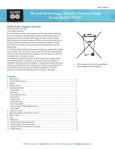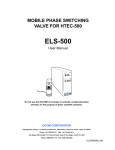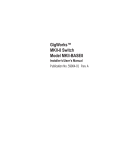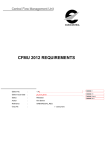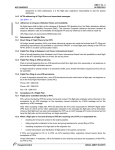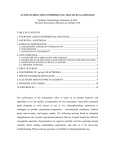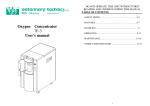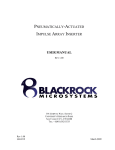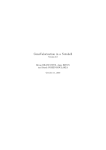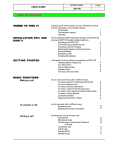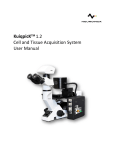Download AtmosLM Large Molecule Sampling Manual
Transcript
User’s Manual AtmosLM Large Molecule Sampling Manual 1. System Set Up Peristaltic Pump Figure 1 shows a typical AtmosLM setup. A syringe pump is used to infuse perfusate and the peristaltic pump is used to withdraw sample from the probe. Always keep the peristaltic pump (ERP-10) at the same level as, or not more than 50cm above, the AtmosLM probe to avoid reduced flow from the outlet line of the probe. Name Syringe Pump (Push Pump) Model ESP-32 ESP-64 Specification 1 motor 2 drive 2 motor 4 drive Peristaltic Pump ERP-10 2 channel Syringe Pump Fraction Collector Fraction CollectorEFC-82Main EFR-82Cooling Unit Freely Moving System ATFM-RA for rats ATFM-MAfor mice AtmosLM Probe PEP-X-Y Polyethylen 1,000 kDa Fig. 1 An Example of System Setup 2. Operation of Peristaltic Pump ERP-10 One RS-5S Peristaltic Tubing can be installed on each side of the roller, upper and lower. Tubing Guide is the groove where the peristaltic tubing, RT-5S, is placed. To move the tubing into place against the rollers, please pull and slide the Knob until you hear a click. The rotation speed shown in the display is NOT the RPM or flow rate, but represents an indication of the rotation speed of the roller head. When you use the RT-5S tubing and set the speed to “0020”, the actual flow rate will be 1 µL/min. Do NOT place the ERP-10 higher than approx. 50 cm, =20 inches above the probe to avoid the flow fluctuations. In order to prolong the life of the RT-5S, please open the Tubing Guides such that they don’t compress the tubing whenever the pump is being stored. Buttons and Actions Up Increases the rotation speed of roller. Down Decreases the rotation speed of roller. CW/CCW Selects the direction of roller rotation, CW indicates Clock Wise and CCW is Counter Clock Wise. If held down for 3 seconds, the rotation speed will be set to 500. If held for 5 seconds, it will be to 1000. Start/Stop Display Operation Buttons Tubing Guide Roller Knob Fig. 2 Peristaltic Pump ERP-10 Starts or Stops the rotation of roller. If held down for 5 seconds, the input value will be memorized and the same value will return after you reboot the unit. US: eicom-usa.com, [email protected] | EU: eicomeurope.com, [email protected] 3. Tubing Setup Connect all tubing as shown in Figure 3. Table1shows the model names of tubing, size, material and approximately internal volume of each tube shown in Fig.3. The tubing between the probe and peristaltic pull pump has to be 0.25 mm ID to allow smooth withdrawal of the sample. 5 7 6 3 4. Peristaltic Tubing Please always use Eicom RT-5S for the tubing set on the ERP-10. Please exchange RT-5S to new one at least every two (2) weeks if you use every day. The lifetime for storage is 6 months. When you do not use the ERP-10, please open the tubing guide to relieve the pressure on the RT-5S. RT-5S Includes Peristaltic Tubing Joint (#RTJ) Internal Diameter Total Length 1 4 2 Fig. 3 Tubing Diagram Details of each tubing and parts on figure is explained on Table 1. Please find corresponding number in the table and this figure. 5 pcs 4 pcs 0.25 mm 83 mm Table 1. Information of Each Tubing Model Name 1. Tubing from Syringe to Swivel Size, Material Approx. Volume JT-10-50 0.1 mm ID x 50 cm, Teflon Tubing Rat WT-35-40 0.1 mm ID x 40 cm, FEP 3.1 µL Mouse WT-25-25 0.1 mm ID x 25 cm, FEP 0.6 µL Rat WT-35-40 0.25 mm ID x 40 cm, FEP 20 µL Mouse WT-25-25 0.25 mm ID x 25 cm, FEP 12 µL 4. Tubing from Swivel to ERP-10 JF-10-50 0.25 mm ID x 50 cm 25 µL 5. Tubing from ERP-10 to Fraction Collector Needle JT-10-50 + FRN-JJ 0.1 mm ID x 50 cm Teflon + 0.12 mm ID x 11 cm PEEK 4 µL + 1.3 µL 6. Liquid Swivel TCS2-21 0.45 mm ID for both in and out, Stainless Steel 316 7. Peristaltic Pump Tubing and Joints RT-5S RTJ Tygon (Vinyl chloride) 0.25 mm ID x 83 mm Stainless Steel 26G x 15 mm JB-30 Biton 0.3 mm ID x your cut 2. Tubing from Swivel to Probe 3. Tubing from Probe to Swivel Joint Tubing 4 µL In 11 µL Out 10 µL Total 6 µL Vary Customized tube lengths are available for JT-10, JF-10 and WT-35. Page 2 of 5 US: eicom-usa.com, [email protected] | EU: eicomeurope.com, [email protected] 5. You will need: aCSF, BSA (Bovine Serum Albumin), 0.2 µm syringe filter, one 5 mL plastic syringe, one 2.5 mL or 1 mL disposable syringe, ethanol 6. Flushing System with Water Flush tubing with water to confirm the flow. At this point, please bypass AtmosLM probe by using a small connector to join the tubing where the probe will be located. If the traveling time of sample is important, we recommend checking the actual traveling time on your system setup. Insert an air gap in the tubing and run the system. Many syringe pumps have a lag time between when the pump is started at the controller and when the actual flow begins. This is because there is a play in the cam and motor gear. So, please first fast forward pump and then switch to normal flow rate before connecting the tubing. 11. Connecting Probe to System Both the syringe and peristaltic pumps should still be stopped and flow rate settings of the syringe pump is at 10 µL/min and ERP-10 is showing “0200”. Remove the bypass where the probe will be placed and connect the inlet and outlet. Start the syringe pump and start the peristaltic pump immediately after confirming a little leak fromt the vent holes. Pay attention there might be a lag time on the syringe pump caused by a mechanical play, see section 6. Confirm that an air segment no larger than approx. 5 cm (= 2 inch, 2.5 µL) has entered the outlet tubing. (see #3, #4 or #5 on Fig. 3). 12. Insertion of Probe 7. aCSF 0.15% BSA Maintain the 10 µL/min flow rate and insert the probe into the animal via guide cannula that has been implanted in advance. If dummy probe is hard to remove, please twist and pull. Maintain the higher flow rate for 2-3 hours in order to prevent clogging of the tubing. Then lower the flow rate to 1 µL/min or your desired flow rate. If necessary, refill the syringe of the syringe pump or switch the syringe by using a liquid switching valve such as the SI-60. 8. Flushing System with aCSF Tips • Set the flow on the peristaltic pump 5% higher than syringe pump. “0021” (=1.05 µl/min) for the peristaltic pump when 1 µL/ min on the syringe speed. Prepare aCSF containing 0.15% BSA (Bovine Serum Albumin) on the day of sample collection. Please do not include buffer components such as carbonate or phosphate in aCSF. It will have more chance to clog in the line during in Vivo use. Filter aCSF with a 0.2 μm membrane filter and fill a Gastight Syringe using on a syringe pump. A connector is still being used in place of the probe. Run both the syringe pump and peristaltic pump at 10 times the normal sampling flow rate to fill the system. To set the peristaltic pump at 10 μL/min, please enter “0200” to the speed. After filling all lines without the probe with aCSF/0.15% BSA, stop both pumps at the same time. 9. Quality Check of Probe Connect a disposable plastic syringe filled with pure/distilled water to the OUTLET (=shorter needle) of the probe. Only use a 1mL or 2.5 mL syringe. Larger syringes can easily generate too much pressure. Then cover the probe’s vent holes with your fingers and depress the syringe plunger gently to fill the probe. Water should be coming out from Inlet needle. Confirm that there are no leaks from tip of membrane or connecting parts of membrane or shaft. The surface of membrane may have sweat, which is normal. • When you lower the flow speed, stopping or lowering the peristaltic pump first and then do the same on the syringe pump to avoid a large air segment in the outlet tube which leads a difficulty of withdrawing sample. • Clogging mostly happens on the tubing #3 or oulet of the probe after the vent. if it happens. To fix, please disconnect the swivel and replace to a 1 mL syringe containg water at the tubing #3 out (see Fig.3 and Fig 4). Then infuse water toward the probe via tubing #3. The flush will come out from the vent and you can use water. 10. Activate Membrane Submerge the membrane in ethanol (70% to 100%, it does not matter) for 1 second. Do NOT keep the probes in ethanol for longer than 5 seconds as this can damage the probe by weakening the glue. The membrane is properly wetted when the opaque white membrane becomes slightly translucent. Now use the plastic syringe to push water into the probe again. 3 Fig. 4 Removing Clog Page 3 of 5 US: eicom-usa.com, [email protected] | EU: eicomeurope.com, [email protected] 13. Maintenance After completing sampling, remove the probe from the system and bypass where the probe was. Open the Tubing Guide on the ERP-10 to prevent tubing occlusion and excess wear of the tubing. Run 50100 times diluted chlorine bleach in the entire tubing from the syringe pump to the fraction collector and let it stand for at least 15 min. Then disconnect all tubing and flush each piece of tubing with water. If you plan on storing the tubing for more than a few days, run ethanol and then air through the tubing, and store them dry. Page 4 of 5 US: eicom-usa.com, [email protected] | EU: eicomeurope.com, [email protected] Appendix 1. AtmosLM Guide Cannual Implant Stereotaxic Appratus Adapotr (PESG-X), Guide Cannual (PEG-X), Dummy Cannual (PED-X), Anchor Screw (AN-3), Cap Nut (AC-5) 1. Set Guide Cannual on Adaptor and Fix with a Cap Cap Nut (AC-5) Nut. Stero Adapter (PESG-X) Guide Cannula (PEG-X) 2. Clamp the PESG-X Please use standard electrode clamp which is provided from your stereotaxic appratus manufacturer. Eicom does not carry this part. Model Number. Kopf 1770, 1771, 1773. Stoelting 51631, 51632, 51634. Clamp of Stereotaxic Apparatus not provided from Eicom 3. Mount Cement Guide cannula crouwn is made of acrylic resin and fuse with cement. Cap Nut does not. Please mount dental cement below the thread of the guide cannual. Dental Cement Ancor Screw (AN-3) 4. Replace Adaptor with Dummy Cannula After confirming the cement is dry and firm, loose the cap nut and remove the PESG-X from the PEG-X guide cannula. Then put PED-X dummy cannula in to the guide and fasten the cap nut. Dummy Cannula (PED-X) Page 5 of 5 US: eicom-usa.com, [email protected] | EU: eicomeurope.com, [email protected]






